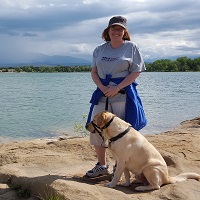Janice Johnson
Round Rock, Texas, United States
On June 28, 2014, Janice Johnson stepped outside with her dog, King, for what she thought would be another ordinary walk around the neighborhood, but in an instant everything changed. King lunged for a sprinting rabbit, taking Janice with him. That night, Janice found herself in the hospital needing surgery for broken bones, but the trauma didn’t end there. She would later be diagnosed with a life-threatening pulmonary embolism (PE), or blood clot in the lungs.
“Unfortunately, I had the leash around my wrist,” Janice recalls. “The next thing I know, I found myself on the ground with a crushed shoulder, a broken arm and two cracked ribs.”
Doctors performed emergency surgery and inserted a steel rod into Janice’s shoulder. The procedure was so successful that they planned to release her the next morning, but Janice felt like something was wrong. She was exhausted and unable to catch her breath without the aid of an oxygen cannula, but she wasn’t sure if that was normal after surgery.
“I don’t do anesthetic very well, and I was in surgery for three hours. So, I just assumed I felt that way because I had been under for so long,” Janice says.
At the age of 57, Janice was in great shape. She and her husband, Reid, had just returned from an extensive camping trip where they hiked almost every day. She knew what if felt like to be tired, but this felt different. “I would be totally exhausted just walking the few steps to the bathroom. I remember sitting in a chair thinking all I want to do is go to sleep. Something just didn’t feel right.”
When the doctor came in to release her, Janice’s nurse asked him to check her oxygen level. It was so low that the doctor immediately ordered several tests to check for blockages in her lungs. Within two hours, doctors diagnosed her with a PE, a condition that she knew nothing about but later learned she had exhibited many major symptoms.
“The strangest thing was that all of the doctors and surgeons know that PEs aren’t uncommon after breaking bones, but it went completely undiagnosed for two days,” Reid says. “Then, after she was diagnosed with a PE, they started taking heroic measures to make sure the blood clot didn’t move. They kept her in the hospital because of the severity of the condition even though they were ready to release her just a couple hours before that.”
At the time, Janice was so exhausted that she could barely react to the diagnosis. “I just remember thinking: I can’t deal with this. I’m just going to let my husband and the doctor take care of this,” she says. “You know that prayer you say as a kid ‘If I die before I wake, I pray the Lord my soul to take,’ – that prayer? I just remember thinking I just have to turn this over to these two guys because I’m out of it.”
Slowly, Janice’s condition began to stabilize, and she began to realize the severity of her circumstances.
“I didn’t know how serious it was until later on that afternoon when my parents and brothers were at the foot of my bed,” she recalls, holding back tears. “I went back into one of my sleep states, and then all of the sudden everybody was there.”
Janice stayed in the hospital for a few more days before being released on the condition that she administer a shot of blood thinners to her abdomen every day for a week.
As a science teacher, Janice feels fortunate that her accident occurred during the summer months when she already had time off, but she still feels like she returned to work too quickly.
“If I had to do it over again, I would have made sure I waited another six to eight weeks to go back to work,” she says. “It kept me from spending time with my students like I had the previous 32 years. I was too tired to attend their ball games or tutor them after school. I would literally come home and be in bed by six o’clock.”
More than a year later, Janice has made a full recovery, but the process was long and arduous. In addition to rehabbing her broken arm and shoulder, Janice was also taking blood thinners for six months which required regular doctor visits and constant monitoring. By March of the following year, she calculates that she had made 152 therapy visits and check-ups in addition to her hospital stay, a costly expense in the United States.
Despite all the setbacks, Janice knows that she is fortunate. Since her accident, she has met many people with stories of loved ones who have died from a pulmonary embolism, but she says she has yet to meet another survivor. “Every day I wake up grateful,” she says as her voice cracks with emotion. “I love being alive.”
Always the teacher, Janice hopes her story can educate others about the signs and symptoms of pulmonary embolism, and she especially wishes to encourage hospital patients to speak up when they feel something is wrong.
“People tell you all the time to be an advocate for yourself and to speak up if you aren’t feeling well, but it’s hard when you’re in that situation. You think – I am just being paranoid or a worry-wart,” she says. “But truly people need to speak up for themselves. If you don’t feel well or feel like something is out of sorts, say something. If you have any sort of hospital stay, and you don’t feel well when they are asking you to leave the hospital, speak up and say something. If I had gone home and not spoken up, I wouldn’t be here today.”

